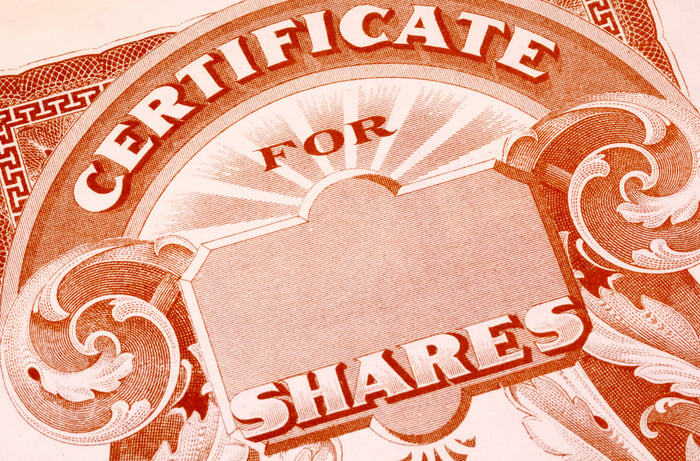Wall Street has been nothing short of a roller-coaster ride since the start of 2020. Investors experienced the quickest bear market decline in history during the COVID-19 crash in 2020, as well as a period of unfettered exuberance in 2021, which sent all three major indexes to record-closing highs. This was followed by another bear market in 2022, and a big-time rally in megacap growth stocks this year.
When volatility and unpredictability rule the roost, professional and everyday investors have a tendency to seek the safety of longtime outperformers. Companies enacting stock splits certainly meet that definition.

Image source: Getty Images.
Investors can't get enough of stocks enacting splits
A stock split is an event that allows a publicly traded company to alter both its share count and share price without having any effect on its market cap or operating performance. This purely cosmetic change can make a company's shares more nominally affordable for everyday investors, or can boost a company's share price to ensure it meets the minimum continued listing requirements of a major stock exchange.
Most investors tend to focus their attention on forward stock splits, which are the type of split designed to reduce a company's nominal share price while increasing its outstanding share count by the same magnitude. Businesses conducting forward splits are usually firing on all cylinders, out-executing their peers, and handily out-innovating their competition.
Since the start of July 2021, eight high-flying companies have conducted forward stock splits, including (listed in chronological order by effective date of split):
- Nvidia (NASDAQ: NVDA): 4-for-1 split in July 2021
- Amazon (NASDAQ: AMZN): 20-for-1 split in June 2022
- DexCom (NASDAQ: DXCM): 4-for-1 split in June 2022
- Shopify (NYSE: SHOP): 10-for-1 split in June 2022
- Alphabet (NASDAQ: GOOGL)(NASDAQ: GOOG): 20-for-1 split in July 2022
- Tesla (NASDAQ: TSLA): 3-for-1 split in August 2022
- Palo Alto Networks (NASDAQ: PANW): 3-for-1 split in September 2022
- Monster Beverage (NASDAQ: MNST): 2-for-1 split in March 2023
What these businesses offer is an abundance of competitive advantages. Without going through every example, you have Nvidia accounting for around 90% of the graphics processing units used in high-compute data centers, Amazon leading the charge in cloud infrastructure services and U.S. online retail sales, Tesla being the world's leading producer of electric vehicles, and Alphabet's Google amassing a virtual monopoly in global internet search share.
In other words, there are good reasons these eight stock-split stocks have outperformed.
Wall Street has its next great stock-split stock
With only Monster Beverage taking the plunge among industry-leading businesses in 2023, investors have been eager to pile into the next great stock-split stock -- and it would appear their wish has been granted.
In August, Danish pharmaceutical giant Novo Nordisk (NVO 1.20%) announced it would be conducting a 2-for-1 forward split on Sept. 20, 2023. This'll mark the fifth split in the company's storied history, and its first since a 5-for-1 split took place in January 2014.
To say that Novo Nordisk is on fire would be an understatement. Shares of the company have tripled over the trailing three-year period, and they're up more than 500% over the trailing decade. Earlier this month, the company surpassed luxury retailer LVMH to become Europe's largest publicly traded company by market cap.
Investors don't have to dig deep to find the catalysts behind this move. Four brand-name therapies have fueled Novo Nordisk's double-digit sales and profit growth: injectable glucagon-like peptide-1 (GLP-1) drugs Ozempic (type 2 diabetes), Saxenda, and Wegovy (Saxenda and Wegovy are both used for chronic weight management), as well as oral type 2 diabetes drug Rybelsus. These four drugs combined for roughly 63% of the $15.45 billion Novo Nordisk recorded in first-half sales in 2023, with respective sales growth of 58%, 36%, 367%, and 97%, from Ozempic, Saxenda, Wegovy, and Rybelsus, from the prior-year period.
What's made GLP-1 drugs such a hot commodity is their ability to induce weight loss in users. GLP-1 receptor agonists like Ozempic (keep in mind that Ozempic isn't approved as a weight-loss therapy), Saxenda, and Wegovy cause the stomach to empty more slowly, which helps users feel fuller and eat less. Further, it signals to the brain that there's still food in the stomach, which can reduce a person's appetite.
As of 2017, the Centers for Disease Control and Prevention estimated that nearly 42% of Americans were obese. In short, Novo Nordisk could be sitting on a gold mine with its GLP-1 injectable therapies.
Wall Street seems to agree. Based on the consensus estimate of analysts in 2026, Novo Nordisk is on track to grow its earnings per share by 116%, and its sales by 87%, compared to what it reported in 2022.

Image source: Getty Images.
This stock-split stock can stay on the pharmacy shelf
While investors have fallen head over heels for stock-split stocks in recent years, this is one upcoming split that I have no intention of grabbing from the pharmacy shelf.
I'm certainly not slighting Novo Nordisk one bit for capitalizing on the success of its GLP-1 injectable products. The U.S. Food and Drug Administration hasn't approved many drugs for chronic weight management, which gives Novo Nordisk a clear path to sustained double-digit sales growth. I fully agree with Wall Street's assessment that the company can deliver double-digit top-line growth in each of the next four years.
Rather, my concerns with Novo Nordisk boil down to two factors: competition and valuation.
To begin with, it'd be foolish (small f) to consider Novo Nordisk as the only player in the GLP-1 receptor agonist space. While it does have three blockbuster therapies growing at a rapid pace, other GLP-1 drugs are being developed that could easily eat into Novo Nordisk's share. This includes orforglipron, an oral nonpeptide GLP-1 receptor agonist from Eli Lilly (LLY -0.40%), as well as danuglipron, which is an oral GPL-1 receptor agonist from Pfizer (PFE 3.32%), to name a few.
A mid-stage study of Lilly's experimental oral GLP-1 drug led to 14.7% mean weight reduction at the 36-week mark in adults who were obese or overweight. Lilly's drug is also being studied for type 2 diabetes. Meanwhile, Pfizer's twice-daily oral GLP-1 candidate produced a reduction in HbA1c levels of up to 1.16% in mid-stage trials, and is also being examined as a weight-loss therapy. Though not all GLP-1 candidates are going to be successful in late-stage trials, Novo Nordisk's bread and butter will, undoubtedly, face competitive pressures in the years to come.
Novo Nordisk's trailing-12-month price-to-sales (P/S) ratio is at an all-time high. NVO PS Ratio data by YCharts.
The other issue for Novo Nordisk is its valuation. While the company's price/earnings-to-growth ratio (PEG ratio) of 1.72 suggests it may still be somewhat cheap relative to its future growth prospects, Wall Street's sales forecasts tell a different story.
Although there is no concrete rule on how to value pharmaceuticals and biotech stocks, given the ever-changing nature of drug pricing and peak sales potential, my personal rule of thumb with drugmakers is that they're fully valued at 6 times forward-looking sales. There may be some exceptions for rare-disease drugmakers that don't have a lot of competition, but that doesn't apply to Novo Nordisk and its type 2 diabetes and obesity drug lines.
Using Wall Street's consensus revenue estimate for 2026, Novo Nordisk is on track for $47.5 billion in annual sales. However, it's already sporting a $437 billion market cap. Investors today are paying 9.2 times sales...in 2026! Things would have to go flawlessly for this valuation to make sense. I don't expect perfection from any publicly traded company, which is why I wouldn't touch this high-flying stock-split stock.







